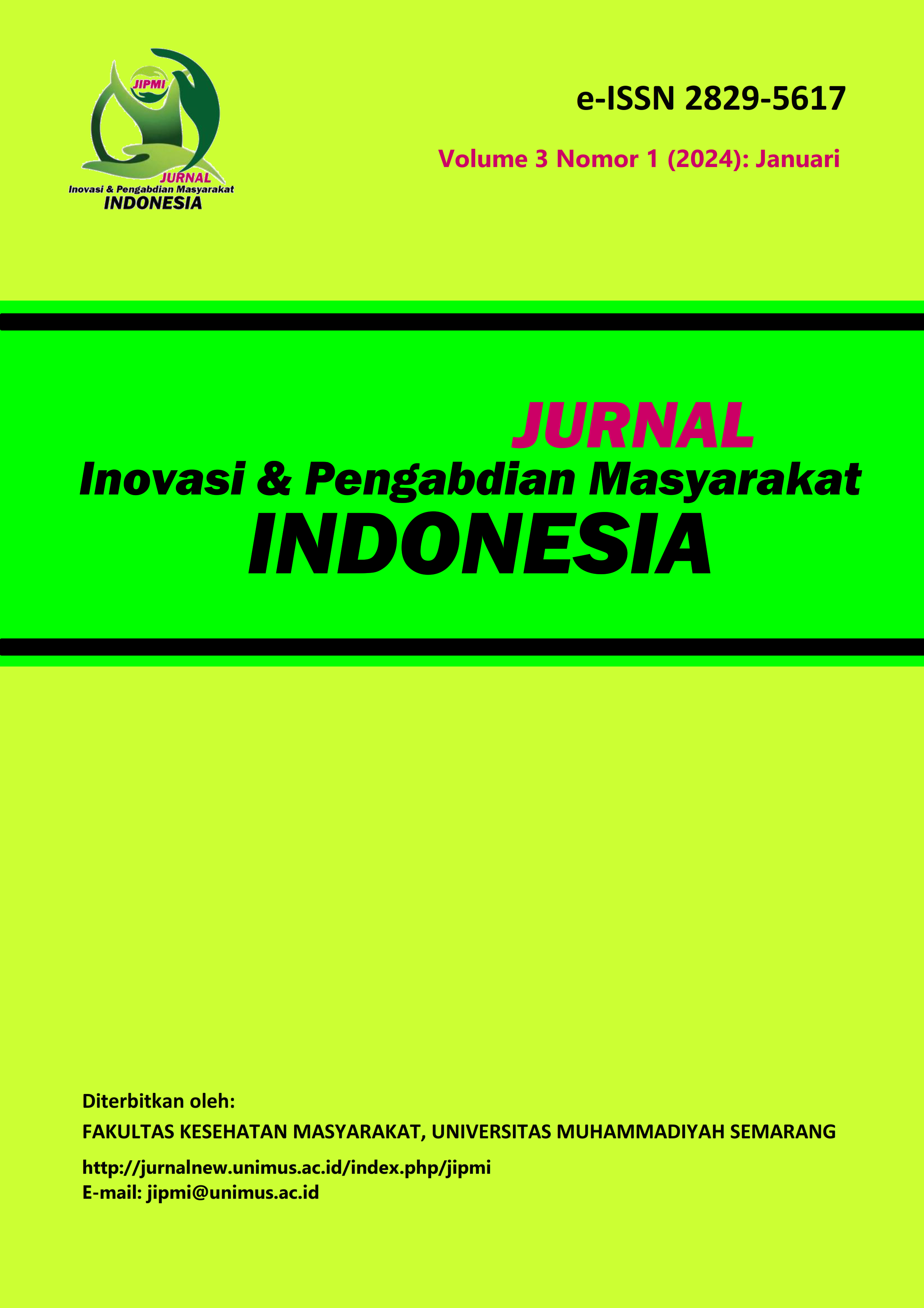Skrining dan Pemeriksaan Mata pada Sivitas Akademika dan Warga di Lingkungan Universitas Muhammadiyah Semarang
DOI:
https://doi.org/10.26714/jipmi.v3i1.291Kata Kunci:
deteksi dini, gangguan penglihatan, kebutaan, kelainan retraksiAbstrak
Latar belakang: Gangguan penglihatan merupakan salah satu permasalahan kesehatan masyarakat yang sangat penting karena dapat menyebabkan kebutaan. Dua penyebab utama tersebut adalah kelainan refraksi yang tidak terkoreksi dan katarak yang tidak dioperasi. Diagnosis dini dan pengobatan akurat adalah satu-satunya metode untuk mencegah gangguan penglihatan. Tujuan: untuk melakukan deteksi dini gangguan penglihatan dengan pemeriksaan mata. Metode: Sasaran kegiatan ini adalah sivitas akademika serta warga sekitar kampus UNIMUS. Pemeriksaan tajam penglihatan dengan Snellen chart dilakukan oleh dokter umum dan dokter muda, dilanjutkan dengan pemeriksaan lanjut dengan slit lamp dan konsultasi gratis dengan dokter spesialis mata. Setelah dilakukan pemeriksaan, pasien mendapatkan obat maupun rekomendasi sesuai diagnosis. Hasil: Kegiatan ini diikuti oleh 88 peserta. Berdasarkan hasil pemeriksaan sebagian besar peserta berusia 20-29 tahun dan memiliki kelainan mata miopi, presbiopi, dry eyes dan astenopia. Kesimpulan: Mayoritas kelainan mata yang dikeluhkan salah satu penyebabnya yaitu perilaku penggunaan gadget. Perlu dilakukan edukasi terkait perilaku sehat penggunaan gadget serta senam mata.
Kata kunci: deteksi dini, gangguan penglihatan, kebutaan, kelainan refraksi
____________________________________________________________________________________
Abstract
Background: Visual impairment is a very important public health problem because it can cause blindness. The two main causes are uncorrected refractive errors and unoperated cataracts. Early diagnosis and accurate treatment are the only methods to prevent visual impairment. Objective: To carry out early detection of visual impairment by eye examination. Method: The target of this activity is residents around the UNIMUS campus. Visual acuity examination with a Snellen chart is carried out by general practitioners and junior doctors, followed by further examination with a slit lamp and free consultation with an ophthalmologist. After the examination, the patient receives medication and recommendations according to the complaint. Result: This activity was attended by 88 participants. Based on the results of the examination, most of the participants were aged 20-29 years and had myopia, presbyopia, dry eyes, and asthenopia. Conclusion: The majority of eye disorders that are complained of are caused by the behavior of using gadgets. Education needs to be carried out regarding healthy behavior in using gadgets and eye exercises.
Keywords: early detection, visual impairment, blindness, refractive errors
Referensi
Al-Lahim WA, Al-Ghofaili RS, Mirghani H. Evaluation of Awareness and Attitudes towards Common Eye Diseases among the General Population of Northwestern Saudi Arabia. Egypt J Hosp Med 2018; 70: 1983–1989.
Resnikoff S, Pascolini D, Etya’ D, et al. Global data on visual impairment in the year 2002. 2004.
Majerníková L, Hudáková A, Obrocníková A, et al. Quality of life of patients with glaucoma in slovakia. Int J Environ Res Public Health 2021; 18: 1–13.
Chew YK, Reddy SC, Karina R. Awareness and Knowledge of Common Eye Diseases Among the Academic Staff (Non-Medical Faculties) of University of Malaya.
Comprehensive eye examination: what does it mean?
Sharmila F, Abinayapriya, Ramprabhu K, et al. Genetic analysis of axial length genes in high grade myopia from Indian population. Meta Gene 2014; 2: 164–175.
Bradley JL, Stillman IÖ, Pivneva I, et al. Dry eye disease ranking among common reasons for seeking eye care in a large US claims database. Clinical Ophthalmology 2019; 13: 225–232.
Lee JTL, Guo X, Li Z, et al. Progression and longitudinal biometric changes in highly myopic eyes. Invest Ophthalmol Vis Sci; 61. Epub ahead of print 1 April 2020. DOI: 10.1167/iovs.61.4.34.
Dandona L, Dandona R. What is the global burden of visual impairment? BMC Med; 4. Epub ahead of print 16 March 2006. DOI: 10.1186/1741-7015-4-6.
Wolffsohn JS, Davies LN, Sheppard AL. New insights in presbyopia: impact of correction strategies. BMJ Open Ophthalmology; 8. Epub ahead of print 30 January 2023. DOI: 10.1136/bmjophth-2022-001122.
Perez VL, Stern ME, Pflugfelder SC. Inflammatory basis for dry eye disease flares. Exp Eye Res; 201. Epub ahead of print 1 December 2020. DOI: 10.1016/j.exer.2020.108294.
Kulkarni U, Soman S, Abdul Aziz A. Do dry eye test results differ in AC and non-AC office rooms? A comparative study in healthy young adults. IP International Journal of Ocular Oncology and Oculoplasty 2020; 6: 63–66.
Yavuz M, Demir T. Depression and anxiety levels and self-concept characteristics of adolescents with congenital complete visual impairment, https://www.researchgate.net/publication/51188615 (2011).
Haddam M, Chakik G, Sammouh F, et al. Digital Eye Strain and Mask Associated Dry Eyes During COVID-19 Pandemic in Lebanon. OSP Journal of Ophthalmology and ocular care 2022; 2: 1–5.
Touma Sawaya R, El Meski N, Saba J, et al. Asthenopia among university students: The eye of the digital generation. J Family Med Prim Care 2020; 9: 3921.
Bansal Yashi, Moudgil Tania. Computer Vision Syndrome. International Journal of Innovative Research & Develepment 2014; 3: 276–279.
Wea MH, Batubara SO, Yudowaluyo A, et al. Hubungan Tingkat Penggunaan Smartphone Dengan Kejadian Miopia Pada Mahasiswa Keperawatan Angkatan VII STIKES Citra Husada Mandiri Kupang.
Unduhan
Diterbitkan
Cara Mengutip
Terbitan
Bagian
Lisensi
Hak Cipta (c) 2024 JURNAL INOVASI DAN PENGABDIAN MASYARAKAT INDONESIA

Artikel ini berlisensi Creative Commons Attribution-NonCommercial 4.0 International License.
















